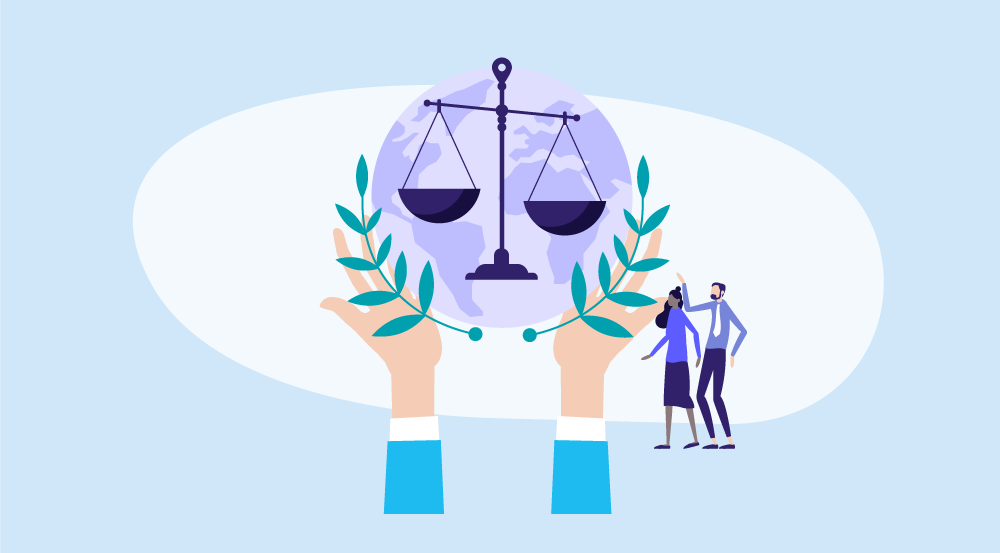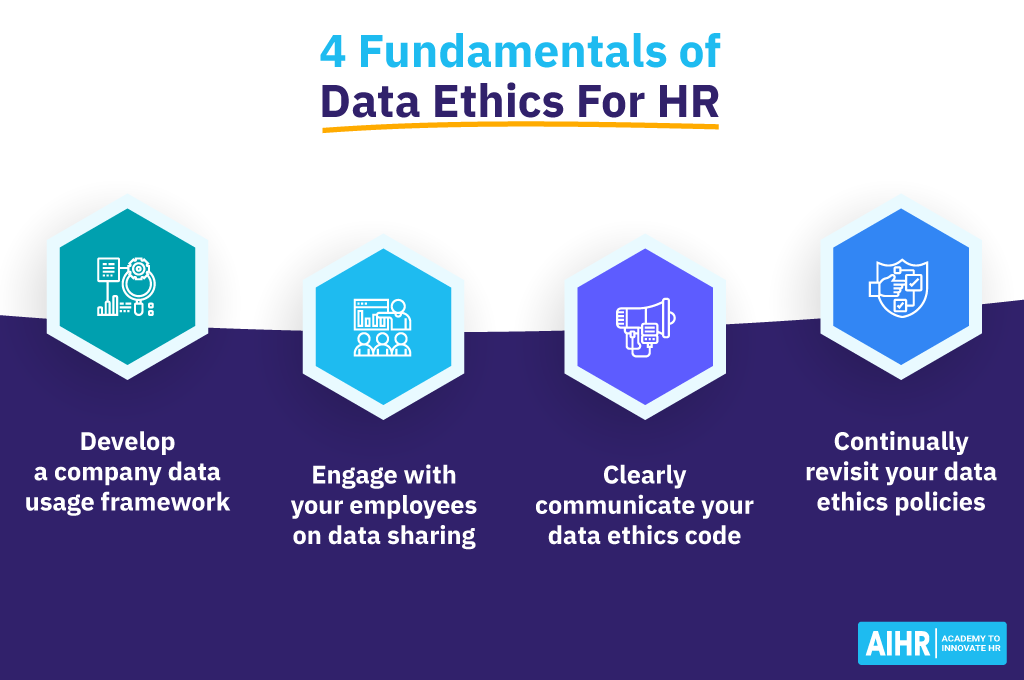Data Ethics in People Analytics: 4 Fundamentals To Follow

Over the past ten years, data and analytics have become an integral part of Human Resources. While most organizations have started to improve the operational aspects of data collection and management, data ethics continue to trail behind. Research by Insight222 found that 81% of people analytics leaders believe ethics or privacy concerns have compromised their data-led projects, and it’s estimated that over 70% of employees have access to data they should not.
By 2025, it’s estimated that individuals and companies worldwide will produce approximately 463 exabytes of data each day, compared to less than 3 exabytes a decade ago. So what are the roadblocks concerning data ethics in HR? Why is data ethics important, and what are the best practices HR professionals can follow to ensure they are handling data responsibly?
Contents
What is data ethics?
Why is data ethics so important for HR professionals?
4 Data ethics fundamentals
What is data ethics?
Data ethics in HR centers on practices that aim to preserve the trust of users, employees, clients, and partners in the workplace. Over the past decade, the use of data and analytics in HR has sky-rocketed, but to perform HR analytics, organizations must collect, store and analyze a plethora of data, some of which will be sensitive.
For example, a large number of businesses use People Analytics for diversity reporting, and this involves dealing with data related to gender, ethnicity, sexual orientation, and age. If this data is not handled correctly or is leaked, it can have a negative physical and mental effect on that employee’s well-being and trigger subconscious biases in the workplace. This is why employees are often hesitant to disclose sensitive data about themselves or share inaccurate information.
Data ethics can only be achieved by taking a transparent, democratic, and ethical approach to the entire data process, but this is easier said than done.
Why is data ethics so important for HR professionals?
Gathering, analyzing, storing, and exchanging employee data presents both a moral and legal challenge for HR professionals. Once you lose the trust of your employees, it isn’t easy to regain it. At its core, people analytics is about people, so data ethics should be at the top of any analytics initiative.
There should be a clear reason—a business objective or challenge—for collecting and analyzing employee data in the first place. Once established, HR should aim to be transparent at every stage and make employees aware of why it’s important to gather this data, how they will collect it, what that data is, how they plan to use it, and who will have access to it. It’s also crucial to respect the privacy and anonymity of your employees and ensure informed consent has been given before you obtain and share personal data. To ensure data remains confidential, it must be stored securely, and access should only be granted to a few HR managers and stakeholders.
Ethical data collection in HR
Collecting data on employees and analyzing it helps HR professionals and business leaders spot patterns, predict future trends, make evidence-based decisions, and gain a competitive advantage. People analytics is undoubtedly changing the field of HR for the better.
However, it rests on employee data being collected and analyzed, which means that HR professionals must do this correctly.
The problem is that this is not always an easy task. A survey by UNLEASH and the IBM Smarter Workforce Institute found that 84% of people believe HR needs urgent guidance on the fair use and privacy of new and emerging data sources in people analytics.
Legislative developments are rapidly changing, as are data processes and technology, which makes it difficult to provide employees with detailed, accurate information. Non-traditional data sources (email, social media, wearables, and sensors) blur the line further. Passive data collection through network analysis and listening tools has increased in line with the number of remote workers as organizations try to remain in control of their sprawling workforce. Plus, the increase of AI-based tools in recruitment and people analytics raises even more data ethics and privacy concerns.
Given the numerous pitfalls that HR professionals face, it’s essential that organizations follow the fundamentals of data ethics and do everything in their power to maintain the trust of their employees while managing business expectations.
4 Data ethics fundamentals
Although data ethics in people analytics can be challenging to navigate, there are certain processes and actions HR teams and business leaders can take to ensure ethics are upheld while using data and analytics for business purposes.
1. Develop a company data usage framework
The first step to data ethics is to develop a company data usage framework for employees.
HR must bring leaders across departments (including the CEO and CDO, legal and compliance teams) together to co-create a data usage framework that reflects the shared mission, vision, and goals for the company and how it plans to harness data.
The CEO (along with other C-suite leaders) must play their part in defining data rules that accommodate ethics and are tailored to their specific industry. Employees must be clear on the potential risks involved with data and which data collection and analytics projects they can and can’t pursue.
For example, a business may decide that a core principle for data usage is only to use data if it is directly linked to improving the working lives of its workers. This data usage framework can be revisited and revised accordingly as the business grows and priorities and technologies change. This helps ensure that data is ethically and efficiently used and supports the overall organizational strategy.
No matter how small or large a business is, data ethics should be considered, and data-protection guidelines should be in place. However, the larger an organization is, the more potential risks and pitfalls there are with regard to data. A clear framework, vision, and rules can prevent data breaches by uniting the company and providing clarity to this murky, confusing landscape.
HR and business leaders need to consider their key goals with data collection and analysis, how this data will improve the business, and develop a data usage framework based on the answer to these pivotal questions.
2. Engage with your employees on data sharing
Even after creating and putting a data usage framework in place in your organization, there will still be gray areas to navigate. There is a danger that HR teams and business leaders may assume that employees are happy with how their data is collected, used, and stored, but this may not be the case.
Gauging your employee’s comfort zones regarding the use of their data is a crucial step to take. HR leadership teams must be champions of employee data ethics and work with their employees to devise a set of principles that build trust in the company’s data usage practices. As the Gartner survey below shows, most employees are willing to share certain types of data.
Important principles that HR should aim to follow:
- Articulate a data ethics code that is rooted in your organizational culture
- Identify and learn from key partners
- Clarify the intent and purpose of any project that uses employee data
- Explicitly communicate what data will be collected, how, and why
- Ensure employees have control and autonomy over their data
- Always ask for feedback from your employees on the process
Often, employees are unaware of how their data is used or the ever-changing laws surrounding data collection and sharing. It’s important to discuss these questions. For example, what is your employee’s current understanding of how their data is used? Where do they expect their data to be used, and where would they not expect it? If your organization has more than one location or employees from around the world, is there a difference in employee expectations in different regions or countries?
Take the example of placing sensors on employees’ work chairs. It may seem harmless enough and the organization may argue that this is important to track because it helps them understand how often employees sit at their desks. This allows them to offer suggestions on standing up and moving around more frequently to improve their health. Secondly, It helps them know how productive people are while sitting at their desks.
On the other hand, employees may not be fine with being tracked in this manner and sharing such detailed information. This is why organizations must be transparent in their data collection initiatives and explain to employees why data is being collected and how it will improve their lives.
Another example is when Amazon received much backlash in the press after being awarded a patent to create wireless wristbands for their warehouse workers. The media argued that this is a gross Big-Brother-esque violation of workers’ rights, while Amazon countered that it would allow the company to improve productivity and employee wellbeing. This will likely be an ongoing conversation over the coming years as data production increases and businesses strive for more information to make strategic decisions.
3. Clearly communicate your data ethics code
Once you have a data usage framework, input, and feedback from your employees, you can create a data ethics code. As soon as this is fully developed, it’s important to communicate it clearly to all employees. There are many ways to achieve this.
HR leaders should have discussions with other departments and business units to speak about how the business plans to use employee data and for what purposes.
The why and the how should then be communicated transparently to all employees: why the business collects certain data and how it will benefit everyone. It’s also important that HR is open with employees before starting any new analytics projects and that with every new initiative, they explain how they will protect employees’ data and use it.
Organizations should give employees some control over their data. For example, providing one place of access where they can view the data the company holds about them and update or correct it if needed.
Be sure to communicate your employee data ethics code on company intranets and career pages.
4. Continually revisit your data ethics policies
The final step to data ethics best practices is to continually monitor and update your policies.
Discuss data ethics policies and analytics goals with leaders and stakeholders to ensure that your data usage framework and policies align with your company’s short- and long-term goals.
Regularly solicit employee feedback to ensure they understand the how and why and their expectations are met.
As you pivot in how you plan to collect and use data and as laws and regulations change, ensure that your data ethics policies reflect these changes.
Key takeaways
- Data and analytics are now integral to HR and can help businesses operate more efficiently and effectively by making strategic, evidence-based decisions.
- Data ethics is becoming an increasing concern as data is collected, used, and stored, often without or with ambiguous consent, which can have a detrimental effect on the health and wellbeing of your employees.
- Data ethics is particularly important for HR professionals as they are champions of their people, so collecting, analyzing, and storing employee data transparently and ethically should be at the top of any analytics initiative.
- Follow data ethics fundamentals by developing a company data usage framework, engaging with your employees on data sharing, communicating your data ethics code, and regularly resisting your policies.
Weekly update
Stay up-to-date with the latest news, trends, and resources in HR
Learn more
Related articles
Are you ready for the future of HR?
Learn modern and relevant HR skills, online













